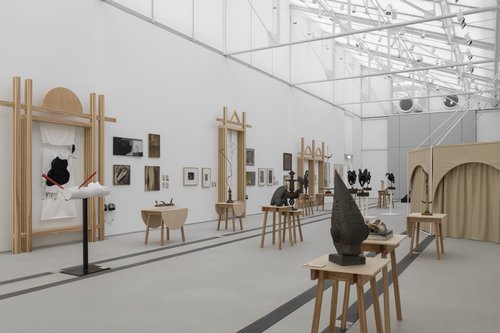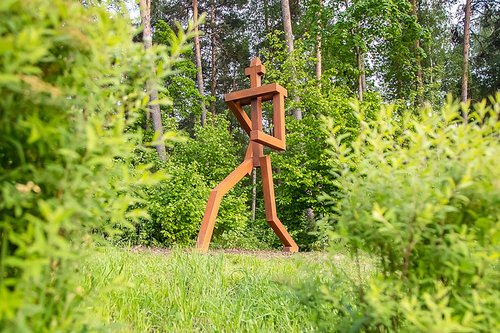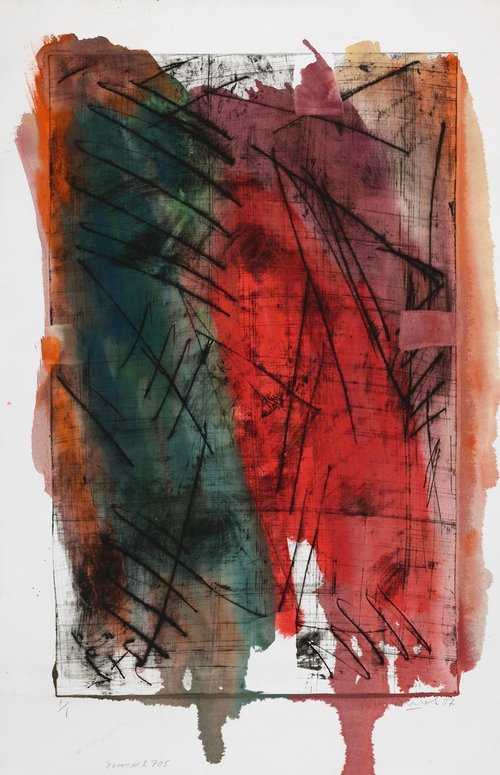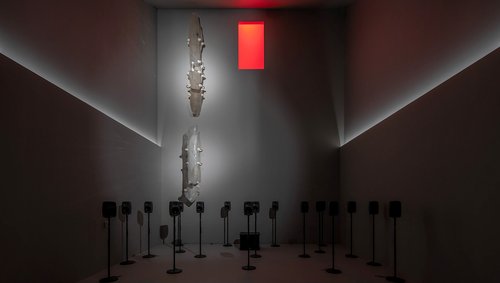Between the Black Square and the Common Pot
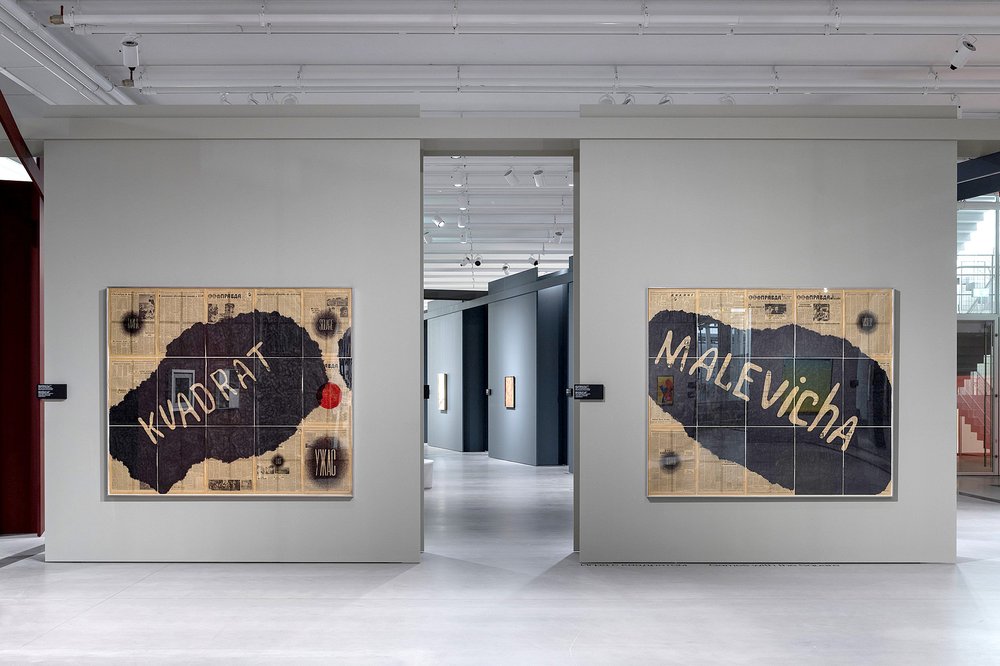
Square and Space. From Malevich to GES-2. Exhibition view. Moscow, 2024. Photo by Daniil Annenkov. Courtesy of Courtesy of GES-2 House of Culture
‘Square and Space. From Malevich to GES-2’ is a summer blockbuster exhibition in Moscow which gives writer Mikhail Sidlin pause for thought as he teases out the ideological programmatic notions that thread through this show.
And Malevich said, “Let there be the Black Square”, and there was the Black Square. GES-2 has put together an ontology in which the Book of Art starts with the Almighty Kazimir. In his artice for the exhibition catalogue curator Francesco Bonami writes, “Malevich’s ‘Black Square’ became the zero mark of painting, and perhaps of art in general.”
Even before it opened, the show piqued interest in the Moscow art community. Firstly, because the co-curators are Italian star curator Francesco Bonami and Zelfira Tregulova, former director of the Tretyakov Gallery. Secondly, the exhibition promised to include not only the golden reserve of the Russian avant-garde, such as Kazimir Malevich (1879–1935), Vassily Kandinsky (1866–1944) and Alexander Rodchenko (1891–1956), but also contemporary artists from the West, something that might raise eyebrows during this era of autarky.
In reality, there are very few works in the exhibition by international artists that have not been seen in Russia many times before. There are works by Jasper Johns (b. 1930), Jörg Immendorf (1945–2007), Jean-Michel Basquiat (1960–1988), Cy Twombly (1928–2011), Michelangelo Pistoletto (b. 1933) and Ralph Goings (1928–2016) which belong to the Ludwig Museum in the Russian Museum and have long been on display at the Marble Palace in St Petersburg. Then a trove of works from the in-house collection of the V-A-C Foundation, whose home is GES-2. They include small pieces by Francis Bacon (1909–1992), Gerhard Richter (b. 1932) and Victor Vasarely (1905–1997), as well as works by Rudolf Stingel (b. 1956), Thierry de Cordier (b. 1954) and Wade Guyton (b. 1972). The loans from Russian state collections include a large canvas by Hermann Nitsch (1938–2022) from the Tretyakov Gallery, and from the State Hermitage Museum there are works by Pierre Soulages (1919–2022), Candida Höfer (b. 1944), Anthony Gormley (b. 1950) and Zaha Hadid (b. 1950–2016). Only two works were loaned directly by the artists themselves, Liu Guoqiang (b. 1988) and Lihi Turjeman (b. 1985) and as this list makes clear, exhibition goers unfortunately face a rollcall of names based on what is available to be shown inside Russia rather than works which show a special affinity with Malevich.
The show starts with a climactic monumental canvas by Anselm Kiefer (b. 1945), ‘Naval Battles Happen Every 317 Years...’ 2016 on loan from a private collection. Although it is not related to Malevich’s Black Square, it does reference Russian Futurism in the guise of madcap genius Velimir Khlebnikov (1885–1922). Khlebnikov, a Russian absurdist poet, considered the number 317 to be fundamental to our understanding the laws of time, and eighteen months before the famous Bolshevik Revolution he planned to establish a ‘Society of 317 members’ to overcome space. Despite this initial promise of meaningful connections between Russian and Western artists that the show trumpets, with such a bold start, there follows little else. Throughout the works are divided into pairs, triples, or there are groups of objects which are connected with one another. Some of these connections are obvious, some are surprising, and some look simply strained.
At first glance some of the parallels the curators have set up seem absurd. Francis Bacon's 1953 ‘Sketch for a Portrait’ from the V-A-C Foundation is hung next to a well-known painting by Russian realist Illarion Pryanishnikov (1840–1894), ‘The Sacrificial Common Pot at the Church Feast’ which GES-2 has borrowed from the Radishchev State Art Museum in Saratov. This painting refers to a festive meal parishoners would eat together from large common pots the day before a church holiday, a practice which has essentially disappeared. You can only make random guesses at the meaning behind this comparision until you read a special book created for the exhibition which is attached to the catalogue. This ‘reading book’ starts with an excerpt from an article by art historian Arkady Ippolitov, who passed away last year, which had originally been written for another exhibition held at the Tretyakov Gallery in 2018. It turns out that this article is programmatic in nature.
Elsewhere, Ippolitov repeats three notions by the Soviet art historian Mikhail Alpatov: the ‘Russianness’ of Russian art; the inseparable connection between icon painting and 19th century realism; and that the essence of ‘Russianness’ is for Alpatov to be found in moral purity and for Ippolitov himself in religious search and the mysticism of light. In other words, the programming behind the show represents a conscious rejection of contemporary artistic thinking and is instead the reduction of criticism to the essentialism of the first half of the 20th century: the ‘Spanishness’ of Spanish art, the ‘Japaneseness’ of Japanese art, and, finally, the ‘Germanness’ of German art, an idea which was most clearly expressed by Alfred Rosenberg. Incidentally, Mikhail Alpatov was the founder of the Department of the History of Russian Art at Moscow State University, established under Stalin during the years of the right turn in Soviet ideology.
The Black Square as the ‘ground zero’ of painting is a neutral thesis in itself. But when it illustrates an outmoded nationalist idea of the superiority of the ‘Russian soul’ and its historical world influence, this thesis is not so much wrong as absurd. It becomes clear that in the context of this exhibition Pryanishnikov's painting about the common pot from which everyone drinks on the eve of a church festival symbolises the ‘Russian soul’ and Bacon's painting symbolises the influence of the Black Square, something that simply does not marry one artwork with the other. It seems to me a violation of logic: if two objects are related to a third, it does not mean that they are related to each other, because they may be related to this third through certain completely unrelated features. Bluntly, the ‘Russian soul’ does not necessarily lead to ‘Black Square’, and the influence of the ‘Black Square’ does not equal the influence of ‘Russian soul’. The notion put forward by Tregulova that Russian art has played a "defining role in the development of the main artistic concepts of the twentieth century from avant-garde to total installation" resembles a conscious rejection of critical theory, post-structuralism and deconstruction in favour of spiritual integralism, oddly refracted around the Black Square.
















